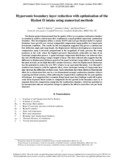JavaScript is disabled for your browser. Some features of this site may not work without it.
| dc.contributor.author | Burrows, Sam | |
| dc.contributor.author | Rana, Zeeshan A. | |
| dc.contributor.author | Prince, Simon A. | |
| dc.date.accessioned | 2024-04-09T11:28:26Z | |
| dc.date.available | 2024-04-09T11:28:26Z | |
| dc.date.issued | 2024-01-04 | |
| dc.identifier.citation | Burrows S, Rana ZA, Prince S. (2024) Hypersonic boundary layer reduction with optimisation of the Hyshot II intake using numerical methods. In AIAA SCITECH 2024 Forum, 8-12 January 2024, Orlando, FL, USA, Article number 2024-2861 | en_UK |
| dc.identifier.uri | https://doi.org/10.2514/6.2024-2861 | |
| dc.identifier.uri | https://dspace.lib.cranfield.ac.uk/handle/1826/21156 | |
| dc.description.abstract | The Hyshot project demonstrated that the quality of flow in a scramjets combustion chamber is essential to achieve critical mass flow condition in a small profiled supersonic combustion chamber. This investigation utilises a steady RANS and real gas thermal model to explore boundary layer growth over various comparable compression ramp profiles in a hypersonic freestream condition. The results in this investigation suggested that given a constant net flow deflection angle and ramp length, the displacement thickness developing on a hypersonic compression ramp is inversely proportional to the magnitude of static pressure the ramp produces at the wall, where the highest pressures theoretically achievable are that of an isentropic compression process. A quasi isentropic compression distribution was achieved when the rate of deflection along a ramp’s length is linear. The data collected also suggests that the difference in displacement thickness growth of the quasi isentropic ramp relative to the nominal flat plate increases as the flight Reynold’s number increases, where the displacement thicknesses has the potential to reduce by over 50% relative to an equivalent flat plate. Low Reynold’s numbers have found to yield the opposite effect, where isentropic turning of a hypersonic flow may increase the difference in these cases. Such reductions have been shown to theoretically allow for a critical mass flow rate in a two dimensional scramjet combustion chamber without requiring slot bleed systems, whilst achieving the required flow conditions for the auto-ignition of hydrogen. It is suggested that a scramjet design based upon these findings would still require some form of porous bleed system to compensate for the growth in the boundary layer as it expands about the compression ramp into the combustion chamber, which has potential to be incorporated onto an axisymetric design to optimise the effective mass flow rate per body diameter. | en_UK |
| dc.language.iso | en_UK | en_UK |
| dc.publisher | AIAA | en_UK |
| dc.rights | Attribution-NonCommercial 4.0 International | * |
| dc.rights.uri | http://creativecommons.org/licenses/by-nc/4.0/ | * |
| dc.subject | Laminar to Turbulent Transition | en_UK |
| dc.subject | Combustion Chambers | en_UK |
| dc.subject | Scramjet Combustion Chambers | en_UK |
| dc.subject | Mass Flow Rate | en_UK |
| dc.subject | Two Dimensional Flow | en_UK |
| dc.subject | Static Pressure | en_UK |
| dc.subject | Freestream Mach Number | en_UK |
| dc.subject | Supersonic Combustion | en_UK |
| dc.subject | Thermal Modeling | en_UK |
| dc.subject | Experimental Flight Test | en_UK |
| dc.title | Hypersonic boundary layer reduction with optimisation of the Hyshot II intake using numerical methods | en_UK |
| dc.type | Conference paper | en_UK |
| dc.identifier.eisbn | 978-1-62410-711-5 |
Files in this item
The following license files are associated with this item:
This item appears in the following Collection(s)
-
Staff publications (SATM) [4398]

